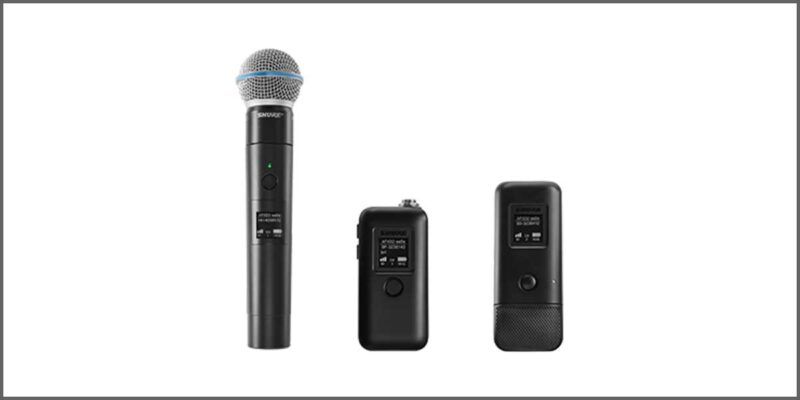Top House of Worship Ads of 2019

2019 was the year of the message if audiovisual (AV) ads aimed at churches were the litmus test. In our annual roundup of advertising dos and don’ts targeting the house of worship (HOW) market, no single persona-specific word was used more frequently than “message” as the key driver for capturing the attention of church AV buyers or, as likely, the influencers who recommend AV technology for their local church.
For rAVe, we have our own message for manufacturers and systems integrators alike: the church market is truly big business and a unique vertical market with a wide demographic. As some of the ads below demonstrate, there’s no single way to reach every church. There are, however, ways to not effectively reach every church. We explore both types of ads below with our take on what AV vendors serving churches can learn from this year’s Top House of Worship Ads of 2019.
This year, we’ve created three categories of ranking for the ads we highlighted in this year-end review: 2019’s Top Ads, Close Contenders, and Not Even Close so that there’s a clear delineation for determining what makes a great ad, a good ad, and even those ads which seem to be out of place in the House of Worship space.
2019’s Top Ads
Ad Campaign: Sweetwater – Equipped for Worship
- Targeted, on-point imagery and text quickly and effectively drives right to the value proposition: This business serves local churches with dedicated staff and understands the needs of the House of Worship Market.
- Because Sweetwater is a vendor, they wisely chose not to highlight any particular brand or product but instead on the WIIFM (What’s In It For Me) principle: from the point of view of the church AV buyer.
- The simplicity of the ad works because it doesn’t pander with catchy phrases.
- The four icons touch on four key pain points for churches: budget, fast-service, tech support, and extended warranties.
- The inclusion of a unique landing page URL is both indicative of their focus on serving the HOW market and also provides a trackable link to identify church buyers who directly typed in the URL instead of using a search engine.
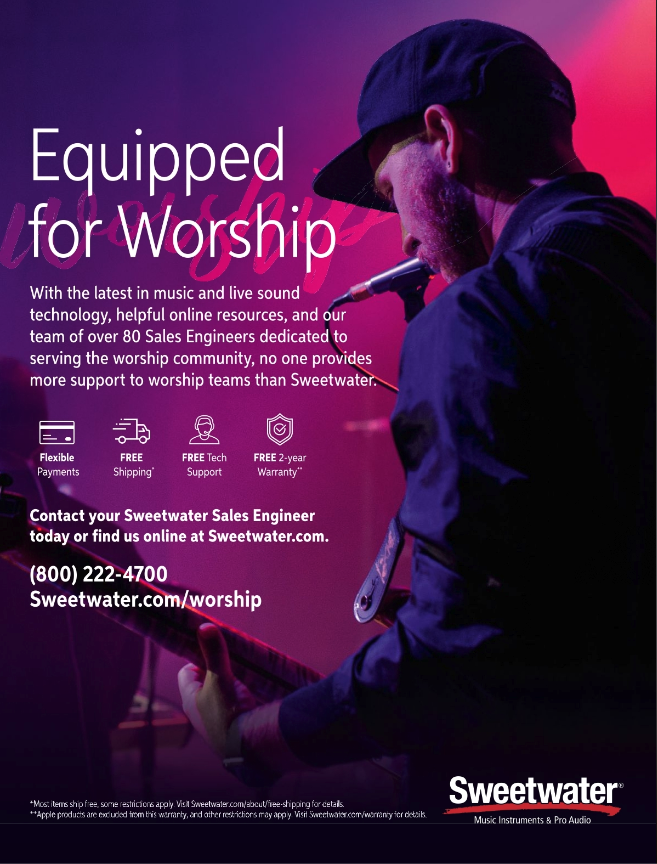
The ad by Sweetwater has a lot of little things working for it, as noted above. The only knock for this ad was that the URL, while clear and obviously focused, is not likely unique enough to allow the Sweetwater marketing team to identify which publication the church buyer saw the ad in so that they had to type in and arrive at the landing page. This simple change would allow for much easier calculation of ROI on ad spend with each publication via a separate and unique link, even if that link simply redirected automatically to the Sweetwater.com/worship page anyway. Tracking for ROI is smart and is the one easy way to improve what is already a terrific ad for reaching church AV buyers.
Sweetwater’s ad is so good in part because they’ve been serving the house of worship market for decades; it’s in their business model. This, if nothing else, is a testament to the buying power of the church market. Vendors like Sweetwater wouldn’t put this kind of effort into a vertical market that didn’t produce solid ROI. That they do should be a reasonable call-to-action for other vendors not yet making this billion-dollar market a priority for 2020 and beyond.
Ad Campaign: QSC – Builders Wanted
- A clever take on the ‘builders’ phrase used by portable church leaders to describe the growth of portable churches and so-called ‘church plants’ (churches started by a denomination or even another church) which often don’t have a building of their own and instead use rented facilities to set up and tear down portable churches each weekend.
- The use of the trailer is ubiquitous with portable churches as the primary storage location for literally every aspect of facilitating a weekend service, including AV gear.
- The ad focuses on portability in one more important way: the simple, lightweight transfer of the product to highlight the form factor of the CP product line.

Unfortunately, though the landing page does include a section for the house of worship buyers, it is mixed among amidst six other applications that have nothing to do with churches. The clever animation is lost far down on the landing page as it is buried six-page scrolls down, which is nice but would have been perfect on a single-focused landing page just for churches. Quite simply, this ad would have been better to have seven distinct landing pages, one for each application highlighted.
The key takeaway for this ad that makes it one of the two top ads of 2019 is the fact that it focuses on solving a specific problem that many churches face: portability. Further, it aligns the QSC brand with the portable church market in particular, and with churches everywhere with needs for at least one small portable sound system. This kind of intentional alignment speaks volumes to the church AV buyers not only in need of this technology but in need of a brand that understands this aspect of the local church.
Close Contenders, But Not Yet Top Ads
Some of the ads this year were closer than many others in past years for reaching the pinnacle of HOW advertisements. However, as we note below, there are key aspects of these ads that kept these from firing on all cylinders.
Ad Campaign: Elation – See the Light and Hear the Message
- The ‘seen but not heard’ implication of this ad headline is aimed at both church AV buyers who have experience with existing moving light fixtures with notoriously loud fans and motors as well as speaking to the inexperienced church AV buyer who simply values the idea of not interfering with the spoken word message.
- The inclusion of a unique email address is both a signal that there is a focus on serving the HOW market and also includes a free lighting design consultation; something that just about every church would benefit from.
- Because of the lighting needs of many modern church services, Elation did a superb job of demonstrating every single product listed in one photo. This kind of holistic solution is ideal for many client types, including churches, which intimates a single point of contact for all support and service requests.
- The inclusion of multiple product photos in the ad could have been highlighted from the photo so that the application/opportunities for other churches was made extraordinarily and overtly clear. This is a truth that vendors need to understand: focus on how your solution adds value/solves problems for churches.
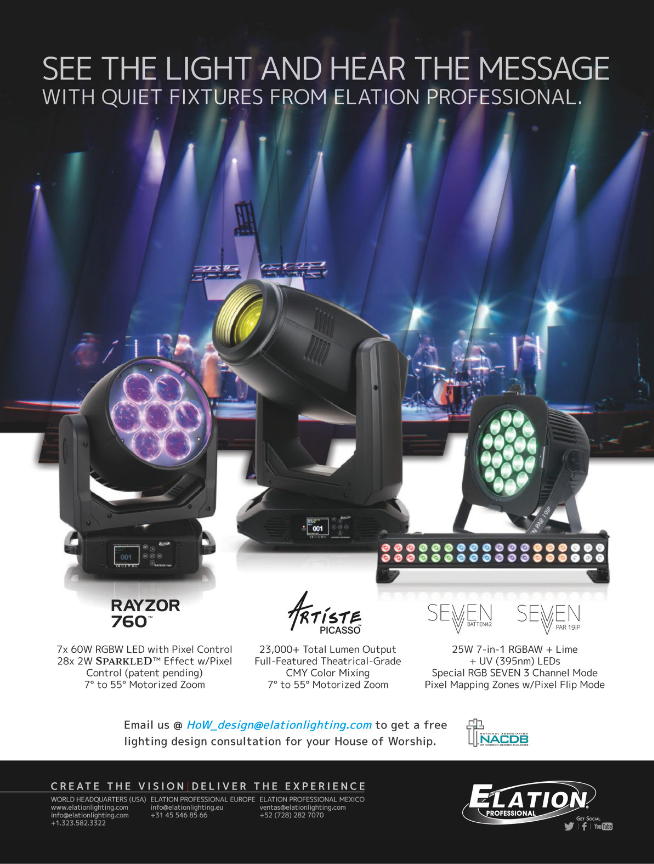
Ad Campaign: Renkus-Heinz — Your Message. Focused.
- The claim “only Renkus-Heinz has the tools necessary to place sound where it’s needed most” seems not only untrue but absurd. Line arrays are by definition ‘steerable’ so this ad feels like the manufacturer is starting right off with a biased sales pitch instead of a strong value proposition. Perhaps a modification of this statement would have been more believable “only Renkus-Heinz offers our custom hardware and software to provide your church with unique steerable arrays to place the sound where it’s needed most.”
- Once the ad starts with such a strong bias, it seems like anything else is going to be too little, too late, though the ad copy does make an important distinction between high-energy ‘contemporary (read, non-traditional) services and the more familiar traditional church service audio needs. Further, the value proposition also focuses on the contrast between small churches and very large church audio needs (so-called ‘mega-churches’ which have >2,000 in weekly attendance).
- The cathedral photo leans toward the traditional church setting, which is more likely to have large ensembles or choirs than modern church service musical stylings. As such, it might not be worth trying to position this as a product for both traditional and contemporary services; simply lean into the traditional church with this ad and create a secondary ad unique to modern ‘black box’ contemporary service types.
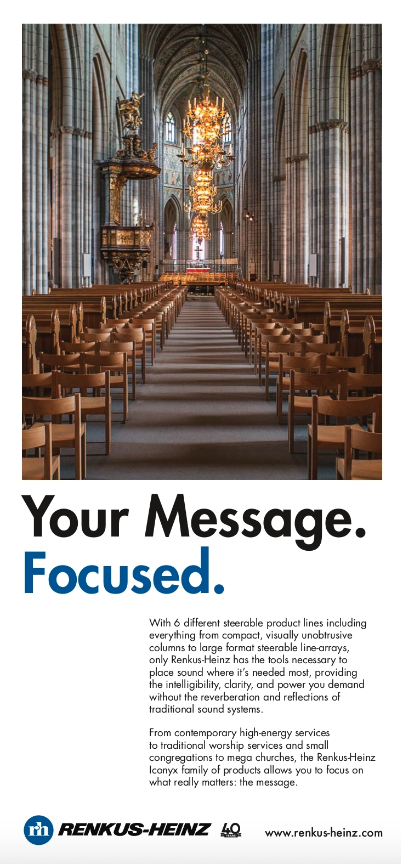
Ad Campaign: Shure – When the message and the moment matters most
- Another focus on the message advertisement play, this ad by Shure uses what looks like a stock photo of a business professional posed during a large company meeting in a large rented venue instead of an actual photo of a clergy member using the product from a church auditorium. To be fair, this photo might be from a contemporary large church, but it doesn’t feel like it, which limits the effectiveness of this ad right from the start.
- The ending line of the ad copy states ‘reach each and every heart’, which does play into the emotional appeal but still falls short of correlation how a microphone helps a pastor reach hearts in and of itself.
- Plus, the advantage of the dual-diaphragm design of the TwinPlex product is not explored, making it hard to imagine why this microphone should potentially replace an existing head-worn mic.
- The landing page (shure.com/twinplex) is entirely product-focused and fails to drive to a church-specific landing page.
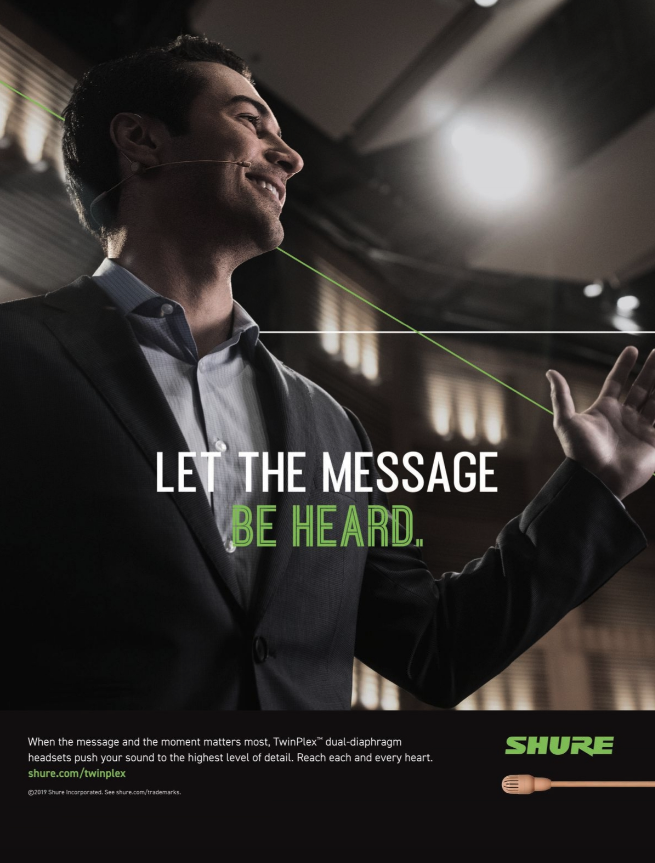
Ad Campaign: Audio Technica – Message Delivered
- Yet another message focused ad, this one by Audio Technica goes product-centric right from the start and stays value-neutral for the House of Worship market right up until the last, grammatically incorrect line: “So no one misses your messages.”
- Since the ad focuses entirely on three product options, the missing opportunity is to quickly highlight the application differences for each model so that church AV buyers can self-qualify which of these products they should consider for their unique church applications.
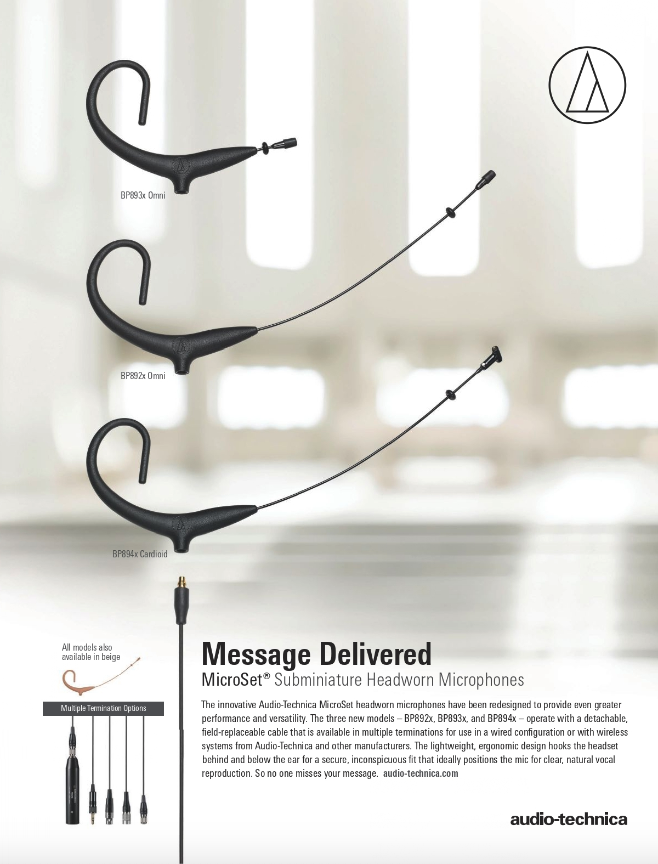
Ad Campaign: Audix – Unwavering Message
- The ‘seen but not heard’ implication of this ad headline is aimed at both church AV buyers who have experience with existing moving light fixtures with notoriously loud fans and motors as well as speaking to the inexperienced church AV buyer who simply values the idea of not interfering with the spoken word message.
- The stylized stained glass photo, similar to the Renkus-Heinz ad reviewed above leans toward the traditional church setting. The same advice applies here: simply lean into the traditional church with this ad and create a secondary ad unique to modern ‘black box’ contemporary service types.
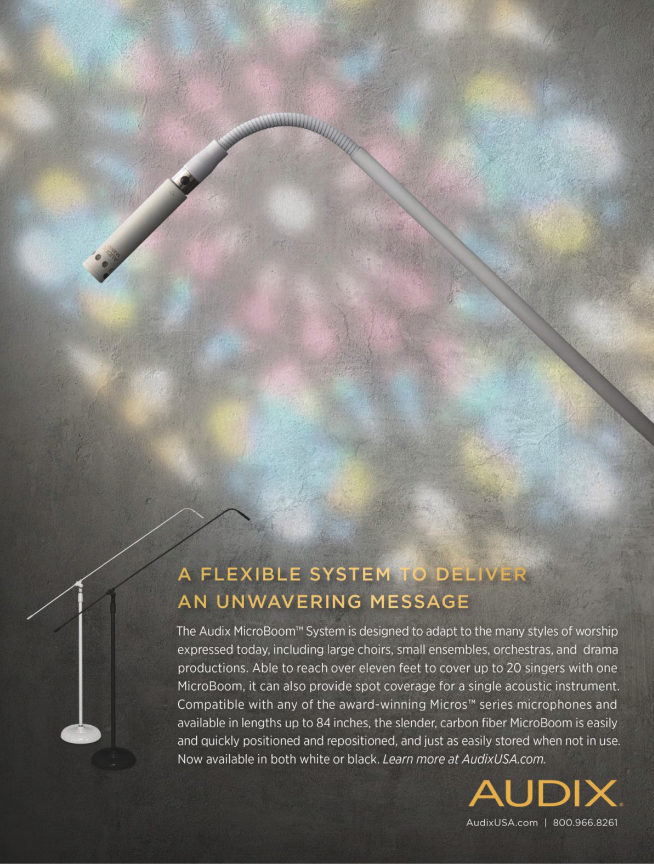
Not Even Close to the Top Ads
We’re not pointing these out because they’re some of the Top House of Worship Ads for 2019 but because they are some of the least-connected ads that seem completely foreign to this vertical market. If anything, it is our opinion and desire for these vendors — and any others with similar misaligned ads — to reflect on our observations and come back with strong ads in 2020 for the HoW market.
Ad Campaign: DPA Microphones – Built for life on the road
- This ad is a swing-and-a-miss for the HoW market because it’s clearly aimed at touring audio needs.
- Even the ad copy focuses on a ‘show’ and musical stylings ‘from folk to metal’ – neither of which are synonymous with most church service musical formats.
- Though DPA is a well-known brand by many churches, this ad feels like good money is thrown into a full-page that’s a full-page whoops as it is not even remotely applicable for the HoW market.
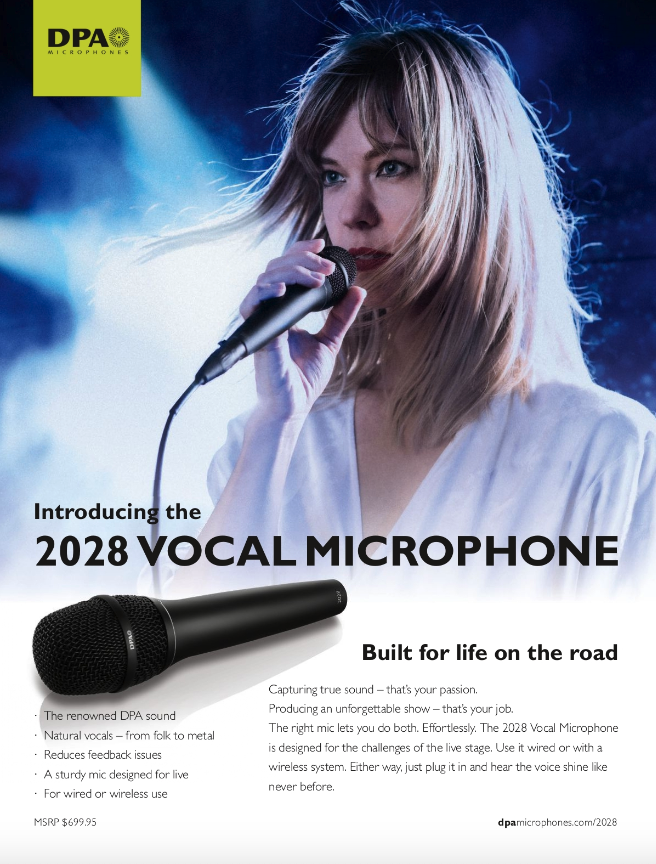
Ad Campaign: Optoma – Visual Solutions from Optoma
- As we have highlighted every year since we began this annual recap of the Top HoW Ads of the year, this ad panders to the HoW market with the use of a dove descending amidst a volumetric ray of light. It’s not only overdone, it feels like Optoma doesn’t really understand the needs of the church market and opted for a cheesy stock photo of a metaphor-infused ad that isn’t going to win any points with church buyers.
- While the ad does attempt to highlight three technologies that might be used in a handful of churches, the lack of compelling church-specific copywriting misses the chance to deliver a powerful value proposition. Plus, the photos used in the simulated pictures for two of the products illustrate a wide contrast and color gamut but are not helpful for demonstrating the application of these products in churches. This could make the church AV buyer wonder if Optoma has sold its products into churches before or is simply trying to cash in on the buying power of this vertical market.
- Finally, the lack of even a landing page (much less an HoW landing page) is lazy marketing and simultaneously makes it impossible for the Optoma marketers to track the ROI of this ad and does the church AV buyer no favors in where to start their potential buying journey beyond the home page of the company.
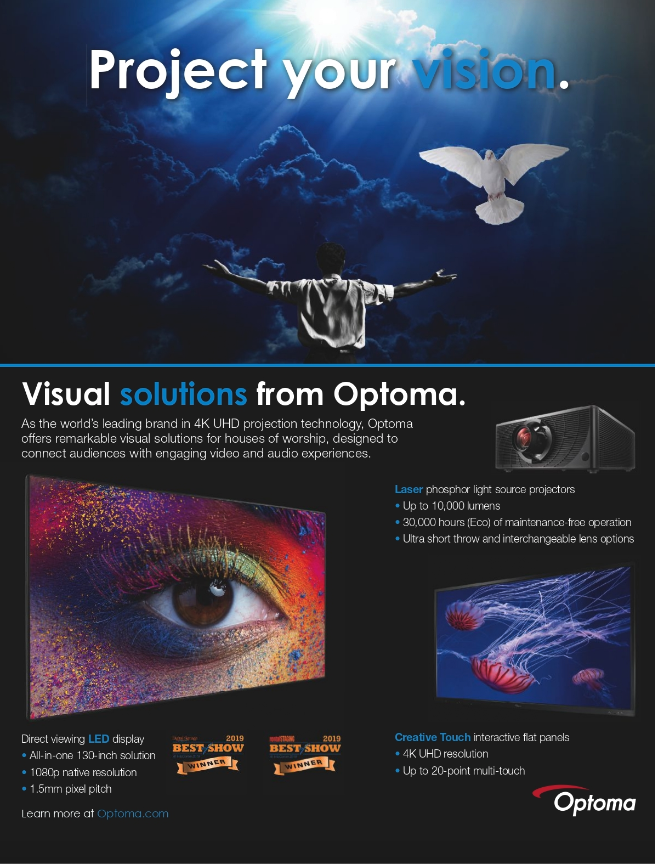
As with any list of subjective reviews, this one is based on opinion but founded on objective criteria by our resident house of worship market expert, Anthony Coppedge. Anthony is widely recognized as a deep expert in both marketing and the church market since he has served on staff at three churches, sold AV as a vendor, consulted with hundreds of churches, and has been a professional marketer for years. We trust Anthony’s insights year after year and hope that these vendors take note of the helpful critiques in this 2019 list of the top house of worship ads so that every vendor listed here — and those which have not yet made the list — make it a priority to come back in 2020 with targeted, value-focused ads for the church market.




